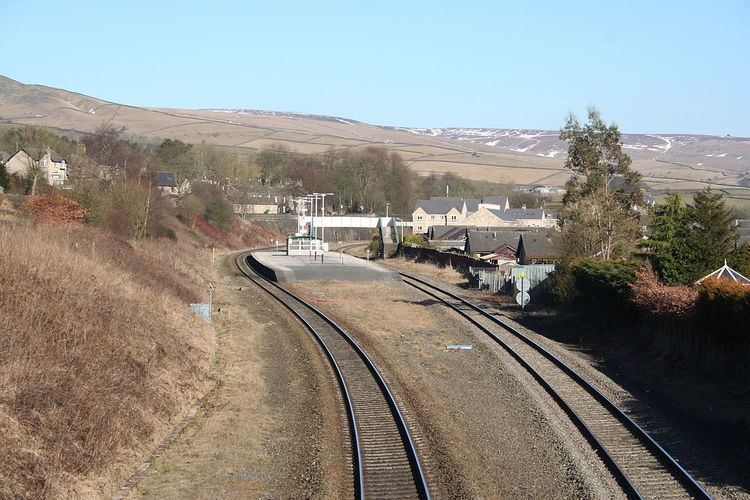Station code CLY DfT category F2 Number of platforms 2 | Grid reference SK038826 Managed by Northern 2011/12 0.103 million | |
 | ||
Address High Peak SK23 6AZ, United Kingdom Similar Edale railway station, Whaley Bridge railway st, Disley railway station, Strines railway station, Chapel‑en‑le‑Frith railway station | ||
Chinley railway station serves the village of Chinley in Derbyshire, England. The station is 17 1⁄2 miles (28.2 km) south east of Manchester Piccadilly, on the Hope Valley Line from Sheffield to Manchester. It is unstaffed, and is managed by Northern.
Contents
History
The original station was built in 1867 by the Midland Railway on the extension of its Manchester, Buxton, Matlock and Midlands Junction Railway which became its main line to London from Manchester. Originally, the Midland had planned to extend through Buxton, but the LNWR already had a line there, so the Midland built a line through Chinley and Buxworth to join the Manchester, Sheffield and Lincolnshire Railway at New Mills, in an association which became known as the Sheffield and Midland Railway Companies' Committee.
From Millers Dale the line crossed the Black Brook valley at Chapel Milton. This became a double viaduct when the Dore and Chinley line was built in 1894, with a north curve forming a triangular junction just over a mile to the east.
In 1902 a new station was built at its present position when the line through Disley Tunnel to Heaton Mersey (and thence on to Manchester Central) was built. It also became the terminus of the Dore and Chinley line instead of Buxton. The old station buildings were dismantled and re-erected on Maynestone Road as a private house. By 1904 Chinley had become an important junction, between Manchester, London St Pancras and Sheffield, with five through platforms & one east-facing bay and four main tracks passing through it. Many expresses from the Midlands & London would call there to attach or detach coaches for destinations in the North West (including Blackburn and Liverpool Central High Level) as well as the main Midland terminus at Manchester Central. This practice became somewhat less prevalent after the 1923 Grouping when the London, Midland and Scottish Railway took over, but in the 1930s some 40 eastbound and 38 westbound trains either called or started/terminated at the station each weekday.
After World War II and the nationalisation of the railways in January 1948, passenger traffic from the station declined and the number of station calls with it, though four southbound London expresses and five from the capital still featured in the station's 1965 timetable. But the 1963 Beeching Report recommended that the Peak District main line to Matlock and Derby be closed, as it duplicated the West Coast Main Line between Manchester Piccadilly and London Euston (which had recently been electrified). The Hope Valley route was not included in the report due to the number of isolated communities it served along its route, but the 1902 line through Heaton Mersey to Manchester Central and the link via Romiley to Stockport Tiviot Dale would also go, all trains henceforth running to Piccadilly via New Mills & Marple.
With the closure of the line to the south in 1967/8 - local passenger services to Buxton (Midland), Rowsley and Matlock were withdrawn from 6 March 1967 and the route closed to passengers the following year (along with the line to Manchester Central west of Cheadle Heath) - Chinley lost its importance. The few surviving London trains via Sheffield ceased to call in the 1972 and had disappeared altogether by 1979. Two of the four lines through the station were subsequently removed in 1981/2 as part of a track rationalisation & re-signalling scheme and the platforms they served were closed (along with the station signal box). The remaining two were then realigned to serve the middle 'island' platform and the surviving buildings demolished.
Since then it has served as a local commuter station on the Hope Valley route, though the line itself still carries significant quantities of freight traffic (mainly limestone aggregates) in addition to a frequent passenger service. Many goods trains that pass through still use part of the old route to Buxton to access the quarries at Peak Forest, whilst the line through Disley Tunnel was reopened to passenger trains in 1986, when a new chord was opened to link it to the Stockport to Buxton line at Hazel Grove. Today all fast Sheffield to Manchester services use this route, in order to call at Stockport whilst the Marple route is used by the local stopping services that call here.
Facilities
There is a waiting shelter on the platform, along with timetable information posters, bench seating and a customer help point. Train running details can also be obtained using the telephone at the station entrance. No level access is available, as the only route from the entrance to the platform is via the stepped footbridge.
Services
The typical off-peak service is one train every two hours to Sheffield and Manchester Piccadilly. This is increased on Saturdays and at peak times to one train per hour in each direction. A limited number of peak hour trains have also terminated or started from here in the past, though none do so in the current (winter 2016-17) timetable.
A limited number of express trains between Sheffield and Manchester Piccadilly (operated by First TransPennine Express and East Midlands Trains) stop at Chinley in the morning & early evening, giving the station through links to and from Liverpool Lime Street, Manchester Airport and Nottingham.
